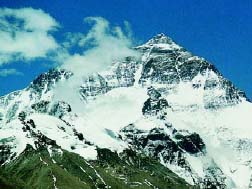
Chinese scientists said new evidence found in Qinghai Province supports the theory that the Qinghai-Tibet Plateau formed 14 million years ago.
This is the first time scientists have found clay and silt deposits in Xining City and Tu Autonomous County of Huzhu in northwest China's Qinghai Province. Previously, similar evidence had been found in Nepal at the south of the plateau, said Lu Huayu a researcher with the Institute of Earth Environment of Chinese Academy of Sciences.
The academics have three theories about the plateau's age. One says it rose up about 2 to 3 million years ago and is still ascending. Another believes it rose up about 8 million years ago in compliance with the synchronized appearance of monsoon and drastic climate changes. The other theory, which the new evidence supports, says the plateau rose to its highest point 14 million years ago and has been collapsing since.
Lu was in charge of a project to drill for clay deposits in Xining City and Tu Autonomous County of Huzhu. Study of the samples in the area supported the theory that the plateau rose up 14 million years ago, Lu said.
The Qinghai-Tibet Plateau in western and southwestern China is the highest plateau in the world, embracing the whole of Tibet and
Qinghai, western Sichuan and southwestern Gansu. It covers an area of 2.3 million square kilometers at an elevation of 3,000 to 5,000 meters.
The appearance of the Qinghai-Tibet Plateau has been an important geological event which had substantially changed the regional and even global climates, Lu said.
Study of the Qinghai-Tibet Plateau calls for joint efforts in geomorphology and climatology. Scientist continue to research the exact age of the plateau, Lu said. (people’s daily)





